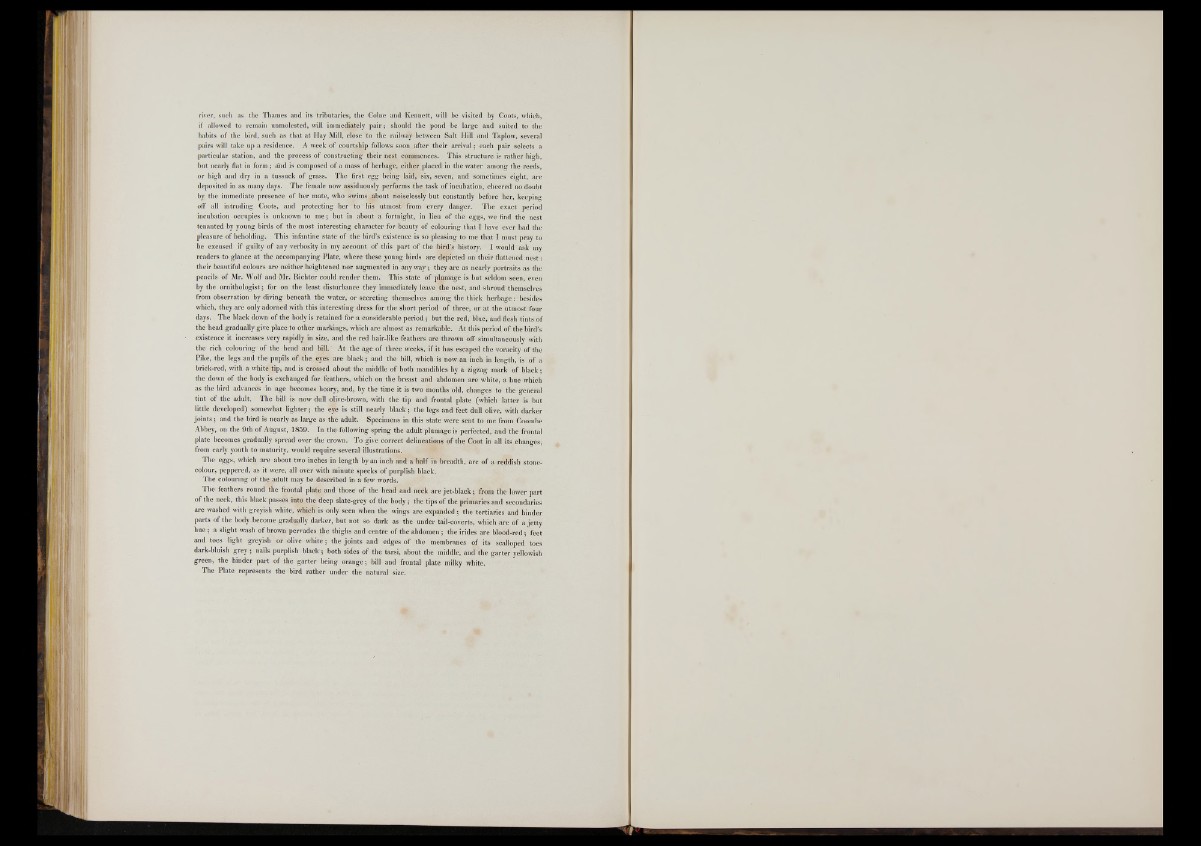
river, such as the Thames and its tributaries, the Colne and Kennett, will be visited by Coots, which,
if allowed to remain unmolested, will immediately p a ir; should the pond be large and suited to the
habits of the bird, such as that at Hay Mill, close to the railway between Salt Hill and Taplow, several
pairs will take up a residence. A week of courtship follows soon after their arrival; each pair selects a
particular station, and the process o f constructing their nest commences. This structure is rather high,
but nearly flat in form ; and is composed of a mass of herbage, either placed in the water among the reeds,
or high and dry in a tussuck of grass. The first egg being laid, six, seven, and sometimes eight, are
deposited in as many days. The female now assiduously performs the task of incubation, cheered no doubt
by the immediate presence of her mate, who swims about noiselessly but constantly before her, keeping
off all intruding Coots, and protecting her to his utmost from every danger. The exact period
incubation occupies is unknown to me ; but in about a fortnight, in lieu of the eggs, we find the nest
tenanted by young birds of the most interesting character for beauty o f colouring that I have ever had the
pleasure of beholding. This infantine state of the bird’s existence is so pleasing to me that I must pray to
be excused if guilty o f any verbosity in my account o f this part of the bird’s history. I would ask my
readers to glance at the accompanying Plate, where these young birds are depicted on their flattened nest :
their beautiful colours are neither heightened nor augmented in any way ; they are as nearly portraits as the
pencils of Mr. Wolf and Mr. Richter could render them. This state o f plumage is but seldom seen, evén
by the ornithologist ; for on the least disturbance they immediately leave the nest, and shroud" themselves
from observation by diving beneath the water, or secreting themselves among thè thick herbage : besides
which, they are only adorned with this interesting dress for the short period o f three, o r at the utmost four
days. The black down of the body is retained for a considerable period ; but the red, blue, and flesh tints o f
the head gradually give place to o ther markings, which are almost as remarkable. At this period o f the bird’s
existence it increases very rapidly in size, and the red hair-like feathers are thrown off simultaneously with
the rich colouring of the head and bill. At the age o f three weeks, if it has escaped the voracity o f the
Pike, the legs and the pupils of the eyes are black; and the bill, which is now an inch in length, is of a
brick-red, with a white tip, and is crossed about the middle o f both mandibles by a zigzag mark o f black ;
the down of the body is exchanged for feathers, which on the breast and abdomen are white, a hue which
as the bird advances in age becomes hoary, and, by the time it is two months old, changes to the general
tint o f the adult. The bill is now dull olive-brown, with the tip and frontal plate (which latter is but
little developed) somewhat lighter ; the eye is still nearly black ; the legs and feet dull olive, with darker
joints ; and the bird is nearly as large as the adult. Specimens in this state were sent to me from Coombe
Abbey, on the 9th o f August, 1859. In the following spring the adult plumage is perfected, and the frontal
plate becomes gradually spread over the crown. To give correct delineations of the Coot in all its changes,
from early youth to maturity, would require several illustrations.
The eggs, which are about two inches in length by an inch and a half in breadth, are of a reddish stone-
colour, peppered, as it were, all over with minute specks o f purplish black.
The colouring o f the adult may be described in a few words.
The feathers round the frontal plate and those o f the head and neck are jet-black ; from the lower part
of the neck, this black passes into the deep slate-grey of the body ; the tips o f the primaries and secondaries
are washed with greyish white, which is only seen when the wings are expanded ; the tertiaries and hinder
parts of the body become gradually darker, but not so dark as the under tail-coverts, which are of a jetty
hue ; a slight wash o f brown pervades the thighs and centre o f the abdomen ; the irides are blood-red ; feet
and toes light greyish or olive white ; the joints and edges of the membranes o f its scalloped toes
dark-bluish grey ; nails purplish black ; both sides of the tarsi, about the middle, and the g arter yellowish
green, the hinder part of the garter being orange; bill and frontal plate milky white.
The Plate represents the bird rather under the natural size.